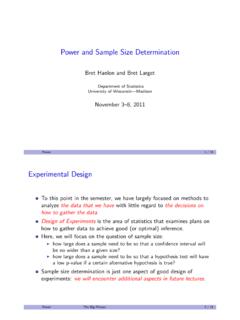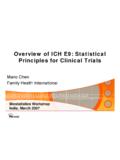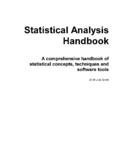Transcription of Solutions to Homework 5 Statistics 302 Professor …
1 Solutions to Homework 5 Statistics 302 Professor LargetTextbook Divorce Opinions and GenderIn Data on page 227, we introduce the results of aMay 2010 Gallup poll of 1029 US adults. When asked if they view divorce as morally acceptable ,71% of the men and 67% of the women in the sample responded yes. In the test for a difference inproportions, a randomization distribution gives a p-value of Does this indicate a significantdifference between men and women in how they view divorce?SolutionIf we use a 5% significance level, the p-value of is not less than = so we would notrejectH0:pf=pm. This means the data do not show significant evidence of a difference in theproportions of men and women that view divorce as morally acceptable . Sleep or Caffeine for Memory?The consumption of caffeine to benefit alternatenessis a common activity practiced by 90% of adults in North America. Often caffeine is used in orderto replace the need for sleep.
2 One recent study compares students ability to recall memorizedinformation after either the consumption of caffeine or a brief sleep. A random sample of 35 adults(between the ages of 18 and 39) were randomly divided into three groups and verbally given a listof 24 words to memorize. During a break, one of the groups takes a nap for an hour and a half,another group is kept awake and then given a caffeine pill an hour prior to testing, and the thirdgroup is given a placebo. The response variable of interest is the number of words participants areable to recall following the break. The summary Statistics for the three groups are shown belowin the table. We are interested in testing whether there is evidence of difference in average recallability between any two of the treatments. Thus we have three possible tests between differentpairs of groups: Sleep vs Caffeine, Sleep vs Placebo, and Caffeine vs Size Mean Standard (a) In the test comparing the sleep group to the caffeine group, the p-value is What isthe conclusion of the test?
3 In the sample, which group had better recall ability? According tothe rest results, do you think sleep is really better than caffeine for recall ability?(b) In the test comparing the sleep group to the placebo group, the p-value is What is theconclusion of the test using a 5% significance level? Using a 10% significance level? How strongis the evidence of a difference in mean recall ability between these two treatments?(c) In the test comparing the caffeine group to the placebo group, the p-value is What isthe conclusion of the test? In the sample, which group had better recall ability? According tothe test results, would we be justified in concluding that caffeine impairs recall ability?(d) According to this study, what should you do before an exam that asks you to recallinformation?Solution(a) The p-value ( ) is small so the decision is to rejectH0and conclude that the mean recallfor sleep ( xs= ) is different from the mean recall for caffeine ( xc= ).
4 Since the meanfor the sleep group is higher than the mean for the caffeine group, we have sufficient evidence to1conclude that mean recall after sleep is in fact better than after caffeine. Yes, sleep is really betterfor you than caffeine for enhancing recall ability.(b) The p-value ( ) is not less than so we would not rejectH0at a 5% level, but it isless than so we would rejectH0at a 10% level. There is some moderate evidence of a differ-ence in mean recall ability between sleep and a placebo, but not very strong evidence.(c) The p-value ( ) is larger than any common significance level, so do not rejectH0. Theplacebo group had a better mean recall in this sample ( xp= compared to xc= ), butthere is not enough evidence to conclude that the mean for the population would be different for aplacebo than the mean recall for caffeine.(d) Get a good night s sleep! Radiation from Cell Phones and Brain ActivityDoes heavy cell phone use affect brainactivity?
5 There is some concern about possible negative effects of radiofrequency signals deliveredto the brain. In a randomized matched-pairs study, 47 healthy participants had cell phones placedon the left and right ears. Brain glucose metabolism (a measure of brain activity) was measuredfor all participants under two conditions: with one cell phone turned on for 50 minutes (the on condition) and with both cell phones off (the off condition). The amplitude of radio frequencywaves emitted by the cell phones during the on condition was also measured.(a) Is this an experiment or an observational study? Explain what it means to say that thiswas a matched-pairs study.(b) How was randomization likely used in the study? Why did participants have cell phones ontheir ears during the off condition?(c) The investigators were interested in seeing whether average brain glucose metabolism wasdifferent based on whether the cell phones were turned on or off.
6 State the null and alternativehypotheses for this test.(d) The p-value for the test in part (c) is State the conclusion of this test in context.(e) The investigators were also interested in seeing if brain glucose metabolism was significantlycorrelated with the amplitude of the radio frequency waves. What graph might we use tovisualize this relationship?(f) State the null and alternative hypotheses for the test in part (e).(g) The article states that the p-value for the test in part (e) satisfiesp < State theconclusion of this test in (a) This is an experiment since the explanatory factor (cell phone on or off ) was design is matched pairs, since all 47 participants were tested under both conditions. For eachparticipant, we find the difference in brain activity between the two conditions.(b) Randomization in this case means that the order of the conditions ( on and off ) was ran-domized for all the participants. Cell phones were on the ears for both conditions to control forany lurking variables and to make the treatments as similar as possible except for the variable ofinterest (the radiofrequency waves).
7 (c) Using onto represent average brain glucose metabolism when the cell phones are on and of fto represent average brain glucose metabolism when the cell phones are off, the hypotheses2are:H0: on= of fHa: on6= of fNotice that since this is a matched pairs study, we could also write the hypotheses in terms of theaverage difference Dbetween the two conditions, withH0: D= 0 vsHa: 6= 0.(d) Since the p-value is quite small (less than a significance level of ), we reject the nullhypothesis. There is significant evidence that brain activity is affected by cell phones.(e) Both of these variables (brain glucose metabolism and amplitude of radiofrequency) are quan-titative, so we use a scatterplot to graph the relationship.(f) We are testing to see if the correlation between these two variables is significantly differ-ent from zero, so the hypotheses areH0: = 0Ha: 6= 0where is the correlation between brain glucose metabolism and amplitude of radiofrequency.
8 (g) This p-value is very small so we rejectH0. There is strong evidence that brain activity iscorrelated with the amplitude of the radiofrequency waves emitted by the cell and , indicate whether it makes more sense to use a relatively large significancelevel (such as = ) or a relatively small significance level (such as = ). your Statistics class as a sample to see if there is evidence of a difference betweenmale and female students in how many hours are spent watching television per Type I error (saying there s a difference in TV habits by gender for the class, when actually thereisn t) is not very serious, so a large significance level such as = will make it easier to see to see if a well-known company is lying in its advertising. If there is evidence thatthe company is lying, the Federal Trade Commission will file a lawsuit against Type I error (suing the company when they are not lying) is quite serious so it makes sense touse a small significance level such as = and , describe what it means in that context to make a Type I and Type II er-ror.
9 Personally, which do you feel is a worse error to make in the given situation? situation described in Exercise I error: Conclude there s a difference in TV habits by gender for the class, when actually3there is no difference. Type II error: Find no significant difference in TV habits by gender, whenactually there is a difference. Personal opinions will vary on which is situation described in Exercise I error: Sue the company when they are not lying. Type II error: Let the company off thehook, when they are actually lying in their advertising. Personal opinions will vary on which Paul the OctopusIn the 2010 World Cup, Paul the Octopus (in a German aquarium)became famous for being correct in all eight of the predictions it made, including predicting Spainover Germany in a semifinal match. Before each game, two containers of food (mussels) were low-ered into the octopus s tank. The containers were identical, expect for country flags of the opposingteams, one on each container.
10 Whichever container Paul opened was deemed his predicted Paul have psychic powers? In other words, is an 8-for-8 record significantly better than justguessing?(a) State the null and alternative hypotheses.(b) Simulate one point in the randomization distribution by flipping a coin eight times andcounting the number of heads. Do this five times. Did you get any results as extreme as Paulthe Octopus?(c) Why is flipping a coin consistent with assuming the null hypothesis is true?Solution(a) The hypotheses areH0:p= vsHa:p > , wherepis the proportion of all games Paulthe Octopus picks correctly.(b) Answers vary, but 8 out of 8 heads should rarely occur.(c) The proportion of heads in flipping a coin isp= which matches the null How Unlikely Is Paul the Octopus s Success?For the Paul the Octopus data inExercise , useStatKeyor other technology to create a randomization distribution. Calculatea p-value. How unlikely is his success rate if Paul the Octopus is really not psychic?











